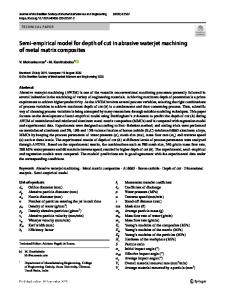Abrasive waterjet machining of three-dimensional structures from bulk metallic glasses and comparison with other techniq
- PDF / 469,955 Bytes
- 6 Pages / 584.957 x 782.986 pts Page_size
- 23 Downloads / 983 Views
Anton Grigoryev INSPIRE AG, 8092 Zurich, Switzerland; and Institute of Machine Tools and Manufacturing (IWF), ETH Zurich, 8092 Zurich, Switzerland
Claus Dold, Carl-Frederik Wyen, and Raoul Roth INSPIRE AG, 8092 Zurich, Switzerland
Eduardo Weingärtner Institute of Machine Tools and Manufacturing (IWF), ETH Zurich, 8092 Zurich, Switzerland
Frank Pude INSPIRE AG, 8092 Zurich, Switzerland
Konrad Wegener INSPIRE AG, 8092 Zurich, Switzerland; and Institute of Machine Tools and Manufacturing (IWF), ETH Zurich, 8092 Zurich, Switzerland
Jörg F. Löfflera) Laboratory of Metal Physics and Technology, Department of Materials, ETH Zurich, 8093 Zurich, Switzerland (Received 25 October 2011; accepted 23 January 2012)
Bulk metallic glasses (BMGs) are a promising class of engineering materials, but they can be difficult to machine due to high hardness and a metastable structure. Crystallization due to machining can have negative effects, such as a decreased load-bearing capacity of fabricated parts, and thus should be avoided. Here, a Zr-based BMG was machined using abrasive waterjet (AWJ), electrical discharge, ns-pulsed laser engraving, and conventional dry-milling techniques. Characterization of the processed material indicated that AWJ preserves the amorphous phase and provides the combination of speed and flexibility required to rapidly fabricate small threedimensional parts, while the other techniques did not achieve these goals. As proof-of-principle, a screw, similar to an orthopedic implant, was rapidly machined from the BMG using AWJ.
I. INTRODUCTION
Certain alloy melts can be solidified without crystallization, producing an amorphous alloy or metallic glass. In the case of small critical cooling rates (1–100 K/s), amorphous specimens with a critical dimension ranging from 1 mm to a few centimeters can be produced by conventional die-casting.1 Bulk metallic glasses (BMGs) possess desirable mechanical, magnetic, thermophysical, and corrosion properties2,3 that make them attractive for a variety of applications including biomedical implants.4,5 The amorphous state is metastable, which limits the amount of heat and/or strain that can be applied during a process such as machining. Crystallization or structural relaxation of the glass may negatively affect the properties of a machined part by, e.g., reducing the load-bearing capacity. Alternatives to machining, such as net-shape a)
Address all correspondence to this author. e-mail: joerg.loeffl[email protected] DOI: 10.1557/jmr.2012.36 J. Mater. Res., Vol. 27, No. 8, Apr 28, 2012
casting,6 thermoplastic forming,7 and blow molding8 have been used to produce complex parts from BMGs. These methods, however, also have drawbacks: net-shape casting of complex parts generates high shear stresses in the melt, which can induce crystallization or create flow defects in the part; thermoplastic forming and blow molding can be performed on limited timescales only and may be applied only to BMGs with high thermal stability. Thus, machining methods that are “nondestructive” with respect to t
Data Loading...











